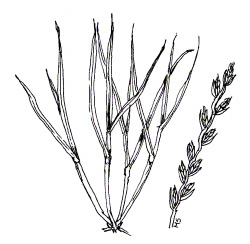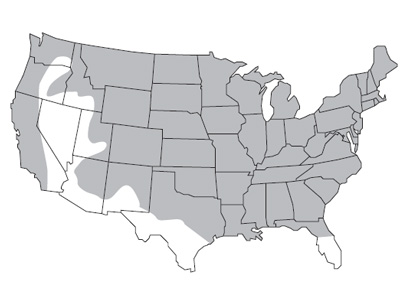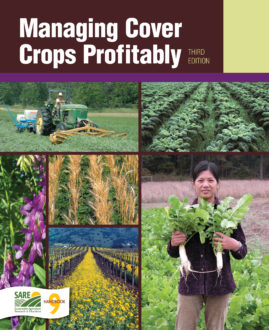Annual Ryegrass (Lolium multiflorum)

Also called: Italian ryegrass
Type: cool season annual grass
Roles: prevent erosion, improve soil structure and drainage, add organic matter, suppress weeds, scavenge nutrients
Mix with: legumes, grasses
See charts for ranking and management summary.
If you want to build soil without investing much in a cover crop, consider annual ryegrass. A quick-growing, non-spreading bunch grass, annual ryegrass is a reliable, versatile performer almost anywhere, assuming adequate moisture and fertility. It does a fine job of holding soil, taking up excess N and outcompeting weeds.
Ryegrass is an excellent choice for building soil structure in orchards, vineyards and other cropland to enhance water infiltration, water-holding capacity or irrigation efficiency. It can reduce soil splash on solanaceous crops and small fruit crops, decreasing disease and increasing forage quality. You also can overseed ryegrass readily into corn, soybeans and many high-value crops.

Benefits of Annual Ryegrass Cover Crops
Erosion fighter. Ryegrass has an extensive, soil-holding root system. The cover crop establishes quickly even in poor, rocky or wet soils and tolerates some flooding once established. It's well-suited for field strips, grass waterways or exposed areas.
Soil builder. Ryegrass’s dense yet shallow root system improves water infiltration and enhances soil tilth. Rapid aboveground growth helps supply organic matter. Expect about 4,000 to 8,000 lb. dry matter/A on average with a multicut regimen, climbing as high as 9,000 lb. DM/A over a full field season with high moisture and fertility.
Weed suppressor. Mixed with legumes or grasses, annual ryegrass usually establishes first and improves early-season weed control. With adequate moisture, it serves well in Hardiness Zone 6 and warmer as a living mulch in high-value systems where you can mow it regularly. It may winterkill elsewhere, especially without protective snow cover during prolonged cold snaps. Even so, its quick establishment in fall still would provide an excellent, winterkilled mulch for early-spring weed suppression.
Nutrient catch crop. A high N user, ryegrass can capture leftover N and reduce nitrate leaching over winter. Provided it survives the winter, its extensive, fibrous root system can take up as much as 43 lb. N/A, a University of California study showed (445). It took up about 60 lb. N/A by mid-May following corn in a Maryland study. Cereal rye scavenged the same amount of N by mid-April on this silt loam soil (372). Ryegrass works well ahead of no-till corn or soybeans in the Corn Belt, sometimes winterkilling, or spray it for a weed-controlling mulch (302).
Nurse/companion crop. Ryegrass helps slowgrowing, fall-seeded legumes establish and overwinter in the northern U.S. , even if the ryegrass winterkills. It tends to outcompete legumes in the South, although low N fertility favors the legume.
Emergency forage. Ryegrass is a very palatable forage (132). You can extend the grazing period in late fall and early spring by letting livestock graze cover crops of ryegrass or a ryegrass-based mix. Annual ryegrass can be used as emergency forage if alfalfa winterkills. It establishes quickly and produces a lot of forage in a short amount of time.
Management of Annual Ryegrass Cover Crops
Ryegrass prefers fertile, well-drained loam or sandy loam soils, but establishes well on many soil types, including poor or rocky soils. It tolerates clay or poorly-drained soils in a range of climates and will outperform small grains on wet soils (132, 421).
Annual ryegrass has a biennial tendency in cool regions. If it overwinters, it will regrow quickly and produce seed in late spring. Although few plants survive more than a year, this reseeding characteristic can create a weed problem in some areas, such as the mid-Atlantic or other areas with mild winters. In the Midwest and Southern Plains, it can be a serious weed problem in oat and wheat crops. It has also been shown to develop herbicide resistance, compounding possible weed problems (161).
Establishment & Fieldwork for Annual Ryegrass Cover Crops
Annual ryegrass germinates and establishes well even in cool soil (421). Broadcast seed at 20 to 30 lb. /A. You needn’t incorporate seed when broadcasting onto freshly cultivated soil—the first good shower ensures seed coverage and good germination. Cultipacking can reduce soil heaving, however, especially with late-fall plantings. Drill 10 to 20 lb. /A, 1/4 to 1/2 inch deep.
Noncertified seed will reduce seeding cost, although it can introduce weeds. Annual ryegrass also cross-pollinates with perennial ryegrass and turf-type annual ryegrass species, so don’t expect a pure stand if seeding common annual ryegrass.
Winter annual use. Seed in fall in Zone 6 or warmer. In Zone 5 and colder, seed from midsummer to early fall—but at least 40 days before your area ’s first killing frost (194). Late seeding increases the probability of winterkill.
If aerially seeding, increase rates at least 30 percent compared to broadcast seeding rate (18). You can overseed into corn at last cultivation or later (consider adding 5 to 10 pounds of red or white clover with it) or plant right after corn silage harvest. Overseed into soybeans at leaf-yellowing or later (191, 194). When overseeding into solanaceous crops such as peppers, tomatoes and eggplant, wait until early to full bloom.
Spring seeding. Sow ryegrass right after small grains or an early-spring vegetable crop, for a four to eight-week summer period before a fall vegetable crop (361).
Mixed seeding. Plant ryegrass at 8 to 15 lb. /A with a legume or small grain, either in fall or early in spring. Ryegrass will dominate the mixture unless you plant at low rates or mow regularly. The legume will compete better in low-N conditions. Seed the legume at about two-thirds its normal rate. Adequate P and K levels are important when growing annual ryegrass with a legume.
In vineyards, a fall-seeded, 50:50 mix of ryegrass and crimson clover works well, some California growers have found (211).
Although not a frequent pairing, drilling ryegrass in early spring at 20 lb. /A with an oats nurse crop or frost seeding 10 lb. /A into overwintered small grains can provide some fine fall grazing. Frost seeding with red clover or other large-seeded, cool-season legumes also can work well, although the ryegrass could winterkill in some conditions.
Maintenance. Avoid overgrazing or mowing ryegrass closer than 3 to 4 inches. A stand can persist many years in orchards, vineyards, and other areas if allowed to reseed naturally and not subject to prolonged heat, cold or drought. That ’s rarely the case in Zone 5 and colder, however, where climate extremes take their toll. Perennial ryegrass may be a smarter choice if persistence is important. Otherwise, plan on incorporating the cover within a year of planting. Annual ryegrass is a relatively late maturing plant, so in vineyards it may use excessive water and N if left too long.
Killing & Controlling Annual Ryegrass Cover Crops
You can kill annual ryegrass mechanically by disking or plowing, preferably during early bloom (usually in spring), before it sets seed (361, 422). Mowing may not kill ryegrass completely (103). You also can kill annual ryegrass with nonpersistent contact herbicides, although some users report incomplete kill and/or resistance to glyphosate (161, 302).
To minimize N tie-up as the biomass decomposes, wait a few weeks after incorporation before you seed a subsequent crop. Growing ryegrass with a legume such as red clover would minimize the N concern. By letting the cover residue decompose a bit, you’ll also have a seedbed that is easier to manage.
Pest Management for Annual Ryegrass Cover Crops
Weed potential. Ryegrass can become a weed if allowed to set seed (361). It often volunteers in vineyards or orchards if there is high fertility and may require regular mowing to reduce competition with vines (422). A local weed management specialist may be able to recommend a herbicide that can reduce ryegrass germination if the cover is becoming a weed in perennial grass stands. Chlorsulfuron is sometimes used for this purpose in California (422).
Insect and other pests. Ryegrass attracts few insect pests and generally can help reduce insect pest levels in legume stands and many vegetable crops, such as root crops and brassicas. Rodents are occasionally a problem when ryegrass is used as a living mulch.
Rust occasionally can be a problem with annual ryegrasses, especially crown and brown (stem) rust. Look for resistant, regionally adapted varieties. Annual ryegrass also can host high densities of pin nematodes (Paratylenchus projectus) and bromegrass mosaic virus, which plant-parasitic nematodes (Xiphinema spp.) transmit (422).
Other Options for Annual Ryegrass Cover Crops
Ryegrass provides a good grazing option that can extend the grazing season for almost any kind of livestock. Although very small-seeded, ryegrass does not tiller heavily, so seed at high rates if you expect a rye grass cover crop also to serve as a pasture. Some varieties tolerate heat fairly well and can persist for several years under sound grazing practices that allow the grass to reseed. As a hay option, annual ryegrass can provide 2,000 to 6,000 pounds of dry forage per acre, depending on moisture and fertility levels (422). For highest quality hay, cut no later than the early bloom stage and consider growing it with a legume. When using ryegrass for grass waterways and conservation strips on highly erodible slopes, applying 3,000 to 4,000 pounds of straw per acre after seeding at medium to high rates can help keep soil and seed in place until the stand establishes (422).
Management Cautions for Annual Ryegrass Cover Crops
Ryegrass is a heavy user of moisture and N. It performs poorly during drought or long periods of high or low temperature, and in low-fertility soils. It can compete heavily for soil moisture when used as living mulch. It also can become a weed problem (361).
Comparative Notes
- Establishes faster than perennial ryegrass but is less cold-hardy
- Less persistent but easier to incorporate than perennial ryegrass
- About half as expensive as perennial ryegrass
- In Southern USA, annual is more adapted and produces much greater biomass
Cultivars. Many varieties are widely available. Improved cultivars should be considered if growing for forage. There are diploid (2n = 14 chromosomes) and tetraploid (4n = 28 chromosomes) cultivars. Tetraploids produce larger plants with wider leaves and mature later.
